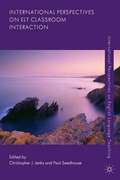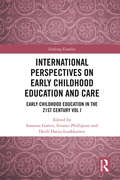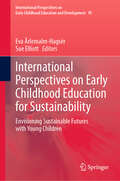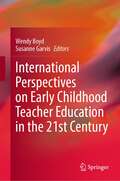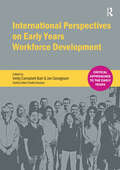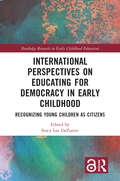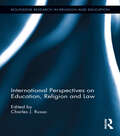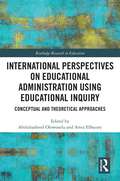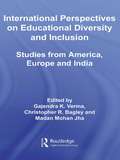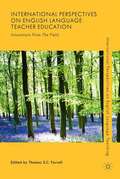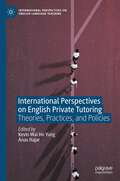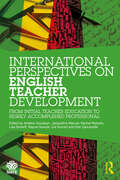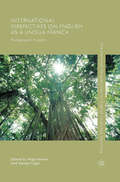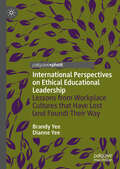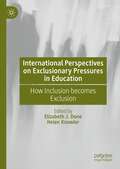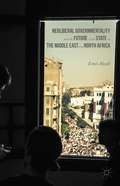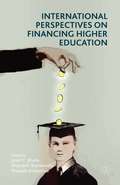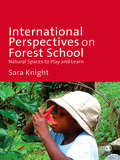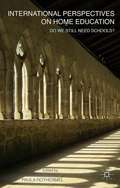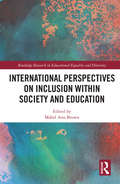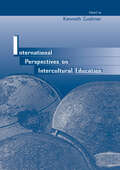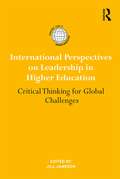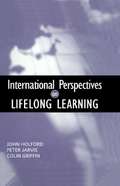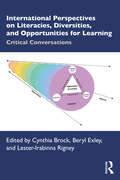- Table View
- List View
International Perspectives on ELT Classroom Interaction
by Paul Seedhouse Christopher J. JenksThe last few decades have seen an increase in interest in classroom interaction, and this has coincided with the global spread of ELT. This book gathers together 11 empirical-based studies of classroom interaction carried out in different countries, including the USA, England, Kenya, Sweden, and China. Implementing methodologies including conversation analysis, corpus-based analysis and discourse analysis, and covering investigatory issues such as CLIL, multilingualism and computer-assistedlanguage learning, each chapter provides cutting-edge accounts of classroom issues and challenges. Along with a state-of-the-art literature review, the chapters provide key insights and engagement priorities that will prove relevant to a variety of learning and teaching contexts.
International Perspectives on Early Childhood Education and Care: Early Childhood Education in the 21st Century Vol I (Evolving Families)
by Susanne Garvis Sivanes Phillipson Heidi Harju-LuukkainenThe first volume in this Early Childhood Education and Care in the 21st Century: International Teaching, Family and Policy Perspectives miniseries provides a snapshot of early childhood education and care from 19 different countries around the world. The intention is to provide a description for the policy and provision for young children and their families in each of the unique contemporary contexts. The selection of countries includes every continent in the world to provide variety across cultures, socio-economic status, location, population and other unique factors. Some chapters also share the development and history of early childhood in their country, including economic and political transitions that lead to changes in early childhood provision and policy. The book provides essential takeaways for early childhood educators, researchers, early childhood organisations, policy makers and those interested to know more about early childhood education within an international perspective.
International Perspectives on Early Childhood Education for Sustainability: Envisioning Sustainable Futures with Young Children (International Perspectives on Early Childhood Education and Development #45)
by Sue Elliott Eva Ärlemalm-HagsérThis international collection of case study chapters addresses early childhood education for sustainability (ECEfS) across diverse national contexts. The book offers critical reflections about what has been achieved to promote ECEfS through policy, research and practice; what might be the lessons learnt for sharing; and, what is yet to be achieved. In pragmatic terms, each national case study incorporates policy, research and practice, alongside illustrative initiatives, stories and images to engage readers. The work provides a systematic understanding of the global ECEfS field and facilitates identification of commonalities, divergences and issues for further analysis and synthesis. The reader is offered a broad text stance incorporating a comparative ECEfS knowledge base and transformative strategies for envisioning sustainable futures with young children. In particular, strategies towards a creative, courageous and radical education that prioritises ethical relationalities with the Earth and sustainable futures for both the human and the non-human species. This is a timely collection in a world where young children are born into climate crises, economic uncertainties and political instabilities alongside their fundamental rights being eroded. Sustainability is conceptualised worldwide in different ways historically, socially and culturally and this is celebrated by the contributing authors throughout the text. Many voices are shared from those working towards global sustainability in early childhood education. This book is aimed at researchers, postgraduate and undergraduate students, and practitioners.
International Perspectives on Early Childhood Teacher Education in the 21st Century
by Susanne Garvis Wendy BoydThis book provides significant information regarding the policies and provisions for early childhood teacher education programs in universities in fourteen different countries. Early childhood education and care (ECEC) is expanding rapidly across the globe with unprecedented numbers of children attending EC centres, requiring the investment in educators to provide good quality ECEC. Yet, there is an inconsistent approach to early childhood teacher preparation and the quality of existing programs is not known.Each country’s contributing author/s is/are well known in their field for their in-depth knowledge of early childhood teacher education programs including content, structure, and professional experience that works within the scope of policy and registration agencies. The chapters address the current situation of staffing—shortage or oversupply—of early childhood teachers in their country. The book informs policy regarding content of early childhood teacher preparation programs and provides evidence of current courses across many under-represented countries throughout the world. It makes a significant contribution to understanding the environment for early childhood teacher programs.
International Perspectives on Early Years Workforce Development (Critical Approaches to the Early Years)
by Jan Georgeson Verity Campbell-Barr Chelle DavisonThis up to date text is suitable for students on all early years and early childhood courses as well as interested practitioners. It looks at the current structure of the early childhood education and care (ECEC) workforce in different countries, each of which represents a distinct philosophical tradition, tracing what has shaped this structure and examining how politics and policy have moulded the workforce over time. Each chapter analyses historical, philosophical and political developments in the respective country and looks at key theorists, the concepts of childhood that have shaped the workforce and the pedagogical approach. The unique aspects of each country are highlighted along with a consideration of what the future might hold for the workforce. Students and practitioners will achieve a more critical understanding of current practice and the beliefs which underpin particular pedagogical approaches while being encouraged to question their own values and practice.
International Perspectives on Educating for Democracy in Early Childhood: Recognizing Young Children as Citizens (Routledge Research in Early Childhood Education)
by Stacy Lee DeZutterThis book brings together established and emerging scholars from around the globe to highlight new directions for research on young children as active, engaged citizens of classrooms. Divided into three sections, the volume draws on innovative methods to explore diverse conceptualizations of citizenship, children’s understandings, and effective practice. Rejecting traditional views of children as citizens-in-preparation, the volume explores how young children can and do live as citizens, and how early childhood educational settings serve as civic forums. Chapters discuss the child-as-citizen in relation to issues including gender, class, race, tribal status, and linguistic diversity, and ultimately illustrate how sociocultural processes in early years settings can be harnessed to promote the development of democratic dispositions and skills. This book establishes citizenship enactment in early childhood education as a robust and growing research area with the potential to shape research, policy, and practice worldwide. As such, it will appeal to researchers and academics with an interest in citizenship education, democracy, and early childhood education, as well as postgraduate students of teacher education and those working across international and comparative education more broadly.
International Perspectives on Educating for Democracy in Early Childhood: Recognizing Young Children as Citizens (Routledge Research in Early Childhood Education)
by Stacy Lee DeZutterThis book brings together established and emerging scholars from around the globe to highlight new directions for research on young children as active, engaged citizens of classrooms.Divided into three sections, the volume draws on innovative methods to explore diverse conceptualizations of citizenship, children’s understandings, and effective practice. Rejecting traditional views of children as citizens-in-preparation, the volume explores how young children can and do live as citizens, and how early childhood educational settings serve as civic forums. Chapters discuss the child-as-citizen in relation to issues including gender, class, race, tribal status, and linguistic diversity, and ultimately illustrate how sociocultural processes in early years settings can be harnessed to promote the development of democratic dispositions and skills.This book establishes citizenship enactment in early childhood education as a robust and growing research area with the potential to shape research, policy, and practice worldwide. As such, it will appeal to researchers and academics with an interest in citizenship education, democracy, and early childhood education, as well as postgraduate students of teacher education and those working across international and comparative education more broadly.Chapter 20 of this book is freely available as a downloadable Open Access PDF at http://www.taylorfrancis.com under a Creative Commons [Attribution-Non Commercial-No Derivatives (CC-BY-NC-ND)] 4.0 license.
International Perspectives on Education, Religion and Law (Routledge Research in Religion and Education)
by Charles J. RussoThis volume examines the legal status of religion in education, both public and non-public, in the United States and seven other nations. It will stimulate further interest, research, and debate on comparative analyses on the role of religion in schools at a time when the place of religion is of vital interest in most parts of the world. This interdisciplinary volume includes chapters by leading academicians and is designed to serve as a resource for researchers and educational practitioners, providing readers with an enhanced awareness of strategies for addressing the role of religion in rapidly diversifying educational settings. There is currently a paucity of books devoted solely to the topic written for interdisciplinary and international audiences involving educators and lawyers, and this book will clarify the legal complexities and technical language among the law, education, and religion.
International Perspectives on Educational Administration using Educational Inquiry (Routledge Research in Education)
by Areej ElSayary Abdulrasheed OlowoseluThis edited volume sets out the current issues that face educational administrative processes and resources across the globe and provides implication‑lead responses for how best to tackle new challenges that arise.Featuring contributions and perspectives from the UAE, Nigeria, Malaysia, Indonesia, Portugal, Spain, Iran and the United States, this diverse and truly international volume discusses the management of resources, tasks and communication key to the smooth running of educational institutions. Divided into four distinct parts, the chapters examine educational administration from theoretical, conceptual and empirical angles, focusing on theories, administrative procedures, decision support systems and management techniques in educational administration, as well as reward management and digital leadership. This book bridges the gap in educational administration by showcasing new trends across many countries and examining the role of theory in the field using examples of classical and contemporary approaches, systems theory, leadership theory, and theories of change and innovation.Ultimately presenting a problem‑solving approach to the current educational administrative situation globally, this volume will be of interest to researchers, scholars and faculty members involved with education administration research, educational administration theory and leadership. Practitioners working on educational process improvement and organizational studies will also benefit from the volume.
International Perspectives on Educational Diversity and Inclusion: Studies from America, Europe and India
by Gajendra K. Verma Christopher R. Bagley Madan Mohan JhaIn light of new theories of multiculturalism and globalization, this insightful book compares approaches to the educational inclusion of diverse minorities– such as the ethnic and linguistic minorities in America. Drawing on their extensive experience, the contributors examine: accounts from cross-cultural cognitive psychology on the special interests and educational needs of certain ethnic groups research on social class divisions, neighbourhood poverty and school exclusions in Britain educational developments for inclusion of minorities in Europe, Greece and Eastern Europe India's educational policies surrounding its struggle to achieve 'education for all' in a nation at the threshold of economic prosperity. This book is unique in its breadth, and scope of its integration of educational policy data generated by different countries, with contrasted minority populations, all at different stages of development.
International Perspectives on English Language Teacher Education
by Thomas S.C. FarrellAs the TESOL profession continues to expand its knowledge-base, what we are still striving to achieve is agreement on a common core expertise of linguistic and pedagogical content domains that language teachers need in order to succeed in their first years and beyond. However, the central issue of what constitutes appropriate disciplinary knowledge and pedagogical content knowledge remains an unresolved issue, requiring teachers and teacher educators to be innovative in both content and delivery. The chapters in this volume outline and discuss examples of teacher educators in diverse global contexts who have provided successful self-initiated innovations for their teacher learners. The collection suggests that a way forward for second language teacher preparation programs is through 'reflective practice as innovation'.
International Perspectives on English Private Tutoring: Theories, Practices, and Policies (International Perspectives on English Language Teaching)
by Anas Hajar Kevin Wai Ho YungThis book focuses on private tutoring (sometimes also known as “shadow education”), an important but neglected topic in applied linguistics and language education research. Private tutoring has become a popular out-of-school learning activity worldwide. While its scope and definition are expanding, private tutoring commonly refers to the “paid service students used to supplement their learning of academic subjects at school outside school hours” (Yung, 2019). Around the world, English language is one of the most popularly enrolled subjects in private tutoring, including both English as a first language and English as an additional language (EAL). Despite its popularity and implications for theories, practices, and policies, research on English private tutoring is still in its infancy. This book aims to provide an international perspective on the interface between applied linguistics and comparative education and open up an agenda for discussion in theories, practices, and policies in English language teaching (ELT). It will be of interest to students, scholars, and policy-makers in these and related areas.
International Perspectives on English Teacher Development: From Initial Teacher Education to Highly Accomplished Professional (National Association for the Teaching of English (NATE))
by Rachel Roberts Andrew Goodwyn Cal Durrant Lisa Scherff Wayne Sawyer Don Zancanella Jacqueline ManuelThe fourth volume in the successful IFTE series provides an international perspective on the knowledge and professional development of the English teaching workforce. It provides a state-of-the-art review of English teaching and teachers and how they are developed over time. With contributions from leading scholars around the world, this volume is divided into four sections that follow the journey of an English teacher from being a student, to the latter stages of professional development and becoming a teacher. It sheds light on how different elements such as school culture, professional development, higher-level qualifications, professional associations and government policies contribute or detract from retention and job satisfaction. International Perspectives on English Teacher Development serves as ideal reading for the research and teacher education community along with teachers and student teachers globally.
International Perspectives on English as a Lingua Franca: Pedagogical Insights (International Perspectives on English Language Teaching)
by Alessia Cogo Hugo BowlesThis collection brings new insight into the relationship between English as a lingua franca and language teaching. It explores how the pedagogy of intelligibility, culture and language awareness, as well as materials analysis and classroom management, can be viewed from an ELF perspective in school and university contexts.
International Perspectives on Ethical Educational Leadership: Lessons from Workplace Cultures That Have Lost (and Found) Their Way
by Brandy Yee Dianne YeeThis book considers ethical educational leadership dilemmas that impact the workplace cultures influencing school districts' success. As school systems become increasingly demographically, racially, and culturally diverse, the need intensifies for educational leaders to lead their school communities in an ethical manner, developing workplace cultures characterized by psychological and emotional safety. Based on research and extensive experience working with school districts in Canada, Germany, Finland, and the United States, Yee and Yee deliver vignettes from various school contexts illustrating ethical leadership dilemmas and leader responses indicative of both toxic and healthy workplace cultures. Finally, the authors present key lessons learned from healthy educational workplaces, illustrating next steps and a call to action for implementing and maintaining ethical school district leadership practices.
International Perspectives on Exclusionary Pressures in Education: How Inclusion becomes Exclusion
by Elizabeth J. Done Helen KnowlerThis book examines and problematises the concept of 'educational inclusion' within schools. Despite varying definitions of inclusion according to national context, there is a growing consensus that educational systems presented as ‘inclusive’ in policy and professional discourse, in practice, legitimise processes that appear far from inclusive. The editors and contributors draw together research from multiple contexts that considers systemic exclusionary pressures and practices from multiple perspectives, particularly less visible forms of social and educational exclusion. The book calls for true inclusion as an overriding socio-political and educational policy objective, and to end the marginalisation of specific groups beyond familiar neoliberal political discourses of piecemeal remediation.
International Perspectives on Financing Higher Education
by Wojciech Bienkowski Josef C. Brada Masaaki KuboniwaHigher education is increasingly important to the labor market success of individuals and the prosperity of nations, yet, as this book shows, public funding for higher education is declining. It presents innovative approaches to increasing funding for universities through closer ties with business and through privatization of universities.
International Perspectives on Financing Higher Education
by Wojciech Bienkowski Josef C. Brada Masaaki KuboniwaHigher education is increasingly important to the labor market success of individuals and the prosperity of nations, yet, as this book shows, public funding for higher education is declining. It presents innovative approaches to increasing funding for universities through closer ties with business and through privatization of universities.
International Perspectives on Forest School: Natural Spaces to Play and Learn
by Sara KnightForest School is now implemented across a wide range of settings both nationally and internationally, and this book explores the global similarities between the Forest School approach and how natural spaces are being used all over the world. Written by a range of international authors, the text includes perspectives from: - Sweden - Portugal - Brazil - Germany - Slovenia - South Africa - Australia - USA and Canada - India It considers the impact that global influences have on early learning, and reflects on how the Forest School approach is used in the UK. With case studies, annotated further reading and points for practice this is a key text for all those studying Early Childhood Studies, Early Years and Primary Education. Sara Knight is Principal Lecturer at Anglia Ruskin University. She is a trained Forest School practitioner and author of Forest Schools For All, Risk and Adventure in Early Years Outdoor Play and Forest School and Outdoor Learning (all published by SAGE).
International Perspectives on Home Education
by Paula RothermelThis collection brings together the research of an eclectic mix of leading names in home-based education studies worldwide. It uses home education to explore contemporary education outside of school and place it into a global, political and critical context, and will be essential reading for home educators, academics and policymakers alike.
International Perspectives on Inclusion within Society and Education (Routledge Research in Educational Equality and Diversity)
by Mabel-Ann BrownInternational Perspectives on Inclusion within Society and Education explores how the theme of inclusion in education and society plays out across different nations and cultures. Covering topics like dual citizenship, political loyalty, and migration, it includes important discussions around poverty, educational disadvantage, youth radicalisation and inequality. With perspectives from a wide range of countries, including the USA, UK, Finland, Kosovo, Albania, Poland, Lithuania, Latvia, Hungary, Czechoslovakia and India, this book explores how issues of inclusion are often decided by a majority for the majority, which can lead to included minorities feeling disadvantaged and paradoxically excluded. While setting up a strong case for inclusion in society and education, it considers factors such as poverty and mental health both nationally and internationally and evaluates the effectiveness of additional financial resources and educational support in creating an inclusive world. This book will be of great interest for academics, researchers, and post graduate students in the fields of comparative education, inclusive education, sociology, political sciences and social work.
International Perspectives on Intercultural Education
by Kenneth CushnerInternational Perspectives on Intercultural Education offers a comprehensive analysis of intercultural education activity as it is practiced in the countries of Australia, New Zealand, Malaysia, the Netherlands, Romania, Spain, England, South Africa, Ghana, Nigeria, the United States, Canada, and Mexico. Chapters by key scholars and practitioners from these nations inform the reader of current educational practice related to diversity. Each author, responding to a common series of guiding questions, presents: *a brief description of the national educational system in her or his country; *descriptive data on demographics in these countries, including data on various subgroups and subcultures and their experiences with the mainstream educational system; * a discussion of the perceived obstacles to addressing intercultural issues in schools and solutions to overcoming these obstacles; and *a comprehensive analysis of intercultural information on how teacher preparation institutions address intercultural education at the present time. An overall concern of each chapter author is how intercultural approaches can be employed to solve the difficulties faced by both individuals and schools while maintaining the cultural integrity of the child.
International Perspectives on Leadership in Higher Education: Critical Thinking for Global Challenges (International Studies in Higher Education)
by Jill JamesonThere is an increasing pressure for leading universities to perform well in competitive global and national ranking systems. International Perspectives on Leadership in Higher Education studies the complexity involved in the development and upkeep of good higher education provision. Without taking anything about leadership, management, governance, administration, authority or power for granted, this book draws together international case studies relating to specific instances of leadership to analyse how they relate to critical thinking and global challenges in higher education. Using a selection of global case studies, this book explores: The extent to which critical thinking on global challenges is employed by higher education leaders, The potential for an increase in the role of critical thinking in leadership, The creative potential for critical leadership thinking to transform institutions and communities, The essential attributes of critical thinking, namely cognitive, affective and social dimensions, and The possibility for critical thinking to contribute to the global public common good by encouraging enhanced research, teaching and public service excellence. Responding to the ever-increasing demands of the higher education climate, International Perspectives on Leadership in Higher Education is a vital resource for anyone occupying leadership positions in higher education institutions and any researchers or students looking to explore the landscape of critical thinking.
International Perspectives on Lifelong Learning
by Peter Jarvis John Holford Colin GriffinTaking an international perspective, the authors examine the theoretical and practical aspects of lifelong learning. A number of issues and key areas of debate are addressed in different national and international contexts and case studies are provided from countries including Hong Kong.
International Perspectives on Literacies, Diversities, and Opportunities for Learning: Critical Conversations
by Beryl Exley Cynthia Brock Lester-Irabinna RigneyThis book explores the conceptual framework, opportunities for learning, as a transaction between literacy learners, mediating agents, and the literacy content to be learned within social, cultural, and historical contexts. With contributions from top scholars from around the world, the chapters in this book provide a window into the varied ways learners, their families, educators, and researchers have co-constructed opportunities for learning in a range of PK-12 classrooms, community settings, and university classrooms across the globe. Building on decades of existing scholarship, contributors conceptualize literacy as social practice and discuss a variety of literacies—including engineering literacies, community literacies, and bilingual and multicultural literacies and more—through real-world and insightful examples. By situating literacy learning in the complex social, cultural, and historical contexts in which students, teachers, and families live and work, chapter authors provide nuanced, qualitative, and deeply profound views of literacy learning. Critical and informative, with a myriad of examples on co-constructed opportunities for learning, this volume is an essential text for graduate courses on literacy education, and for literacy researchers, teacher educators, and teachers.
